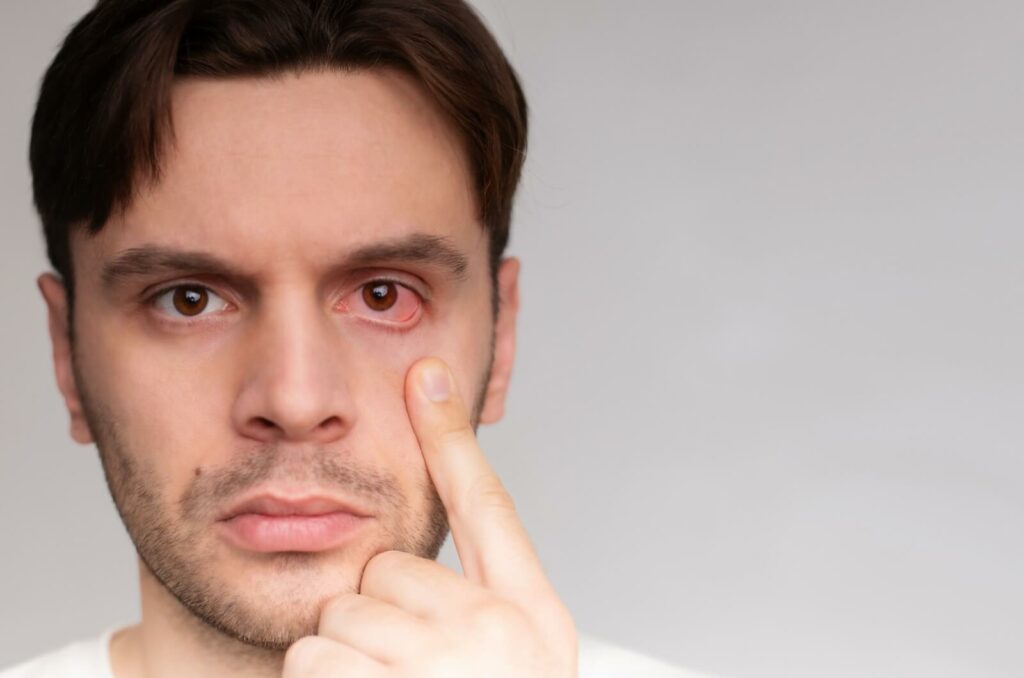Pink eye, also known as conjunctivitis, is a common eye infection that causes redness and inflammation of the conjunctiva – the membrane on the inner surface of the eyelid and the white part of the eye. It can be caused by viruses, bacteria, allergies or irritants.
While pink eye is easily recognizable and usually not serious, it can sometimes be confused with other conditions that have similar symptoms. In fact, several conditions are commonly misdiagnosed as pink eye including:
- Allergic conjunctivitis
- Dry eye syndrome
- Corneal abrasion or scratch
- Foreign body in the eye
Allergic Conjunctivitis
Allergic conjunctivitis is a common condition that occurs when the eyes come into contact with an allergen, such as pollen, dust, or pet dander. This can cause inflammation of the conjunctiva and lead to red, itchy, and watery eyes–similar to symptoms of pink eye.
One way to differentiate between allergic conjunctivitis and pink eye is by observing other allergy symptoms such as sneezing, runny nose, or sinus congestion. Additionally, allergic conjunctivitis often affects both eyes whereas pink eye usually only affects one eye.
Dry Eye Syndrome
Dry eye syndrome is a condition where the eyes do not produce enough tears or the tears evaporate too quickly, resulting in dry and irritated eyes. This can lead to redness, burning sensation, and blurred vision– also similar to symptoms of pink eye.
However, unlike pink eye, dry eye syndrome is a chronic condition that requires long-term management. If you are experiencing persistent dryness and irritation in your eyes, it’s important to consult an eye doctor for proper diagnosis and treatment.
Corneal Abrasion or Scratch
A corneal abrasion or scratch occurs when the protective outer layer of the cornea is damaged, usually from a foreign object or trauma to the eye. This can cause redness, pain, and sensitivity to light–similar symptoms to pink eye.
If you suspect you have a corneal abrasion or scratch, seek medical attention immediately as it can lead to further complications if left untreated.
Foreign Body in the Eye
A foreign body in the eye, such as an eyelash or speck of dust, can also cause symptoms similar to pink eye. It may lead to redness, irritation, and watery eyes.
To determine if there is a foreign body in your eye, gently flush it out with water or try using artificial tears. If the symptoms persist or worsen, consult an eye doctor for further examination.
How to Identify & Treat Pink Eye

Pink eye can be caused by a variety of factors, including viruses, bacteria, allergens, or irritants. The best way to identify the specific cause is through a proper examination by an eye doctor.
If you do have pink eye, treatment will depend on the underlying cause. Viral conjunctivitis usually clears up on its own within a week or two, while bacterial conjunctivitis may require antibiotic eye drops. Allergic conjunctivitis can be managed with antihistamines and avoiding triggers.
It’s important to note that pink eye is highly contagious, so it’s crucial to practice good hygiene and avoid contact with others until the symptoms have resolved. If you wear contact lenses, it’s important to discontinue use until the infection has cleared.
Prevention Tips for Pink Eye
Here are some tips to keep in mind to prevent pink eye:
- Wash your hands frequently, especially before touching your eyes. Keeping your hands clean is one of the most effective ways to avoid transferring bacteria or viruses to your eyes.
- Avoid sharing personal items such as towels or eye makeup with others. Sharing these items can easily spread infections, so it’s best to keep your personal items to yourself.
- Clean and disinfect contact lenses properly according to the instructions from your eye doctor. Always wash your hands before handling your lenses and ensure that your lens case is also cleaned regularly to prevent contamination.
- If you have allergies, try to avoid triggers and use antihistamines if necessary. Managing your allergies can help reduce the likelihood of allergic conjunctivitis, which can mimic pink eye symptoms.
- Use sunglasses or protective eyewear in windy or dusty environments. This helps shield your eyes from irritants that can lead to inflammation or infection.
- Avoid touching or rubbing your eyes, as this can introduce germs and irritants. If your eyes feel itchy or uncomfortable, try rinsing them with clean water instead.
- Stay away from swimming pools or hot tubs if you know there is a risk of infection. Chlorine can irritate your eyes, and crowded public pools can be a breeding ground for bacteria.
- Maintain good overall hygiene by keeping your living spaces clean and avoiding contact with sick individuals. Regularly disinfect commonly touched surfaces and practice good respiratory hygiene to minimize the risk of spreading germs.
By following these simple tips, you can significantly reduce your chances of developing pink eye and keep your eyes healthy.
Protecting Your Vision at Maple Ridge Eye Care
Pink eye may not seem like a serious condition, but it’s important to take it seriously and seek proper medical care. By understanding the symptoms, causes, and treatment options available for pink eye, you can protect yourself and those around you from this highly contagious infection. Remember to practice good hygiene and follow prevention tips to reduce your risk of developing pink eye in the first place.
At Maple Ridge Eye Care, our team is dedicated to providing comprehensive eye care services, including diagnosis and treatment for pink eye. If you’re experiencing symptoms or have any concerns about your eye health, don’t hesitate to schedule an appointment with us. Your eyesight is precious and we’re here to help you maintain it.


